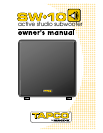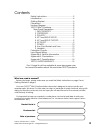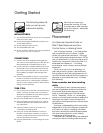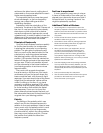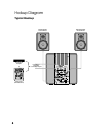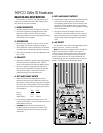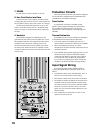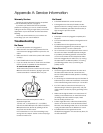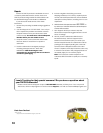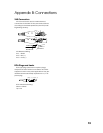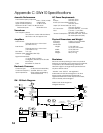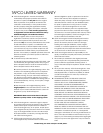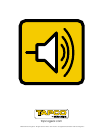
10
7. POWER
Use this switch to turn the SW•10 on and off.
8. Line Cord Socket and Fuse
Connect the line cord to this IEC socket securely,
and plug the other end into your AC outlet. Make sure
the AC SELECT switch is set to the correct AC voltage.
The fuse is located behind the fuse cover, at the
bottom of the IEC socket. See the “Troubleshooting”
section on page 11 for information about replacing
the fuse.
9. Heatsink
The heatsink is designed to dissipate the heat
generated by the built-in power amplifi er. The cooler
the amplifi er operates, the longer its life-expectancy.
The SW•10 uses convection cooling, where cool
air fl ows through the fi ns of the heatsink and carries
the heat away. Make sure there is at least six inches
clearance between the back of the SW•10 subwoofer
and the wall.
Protection Circuits
There are several protection mechanisms designed
into the SW•10 to safeguard the loudspeakers and
amplifi ers from inadvertent damage.
Peak Limiter
A peak limiter monitors the amplifi er output
signal to guard against clipping and overloading
the amplifi er. This allows for loud punchy bass
performance without distortion, ensuring long-term
reliability.
Thermal Protection
All amplifi ers produce heat. The SW•10 is designed
to be effi cient both electrically and thermally.
• If for some reason the heatsink gets too hot, a
thermal switch activates and turns off the amplifi er.
• When the heatsink cools down to a safe
temperature, the thermal switch resets and normal
operation resumes.
• If the heatsink temperature again gets too hot, the
shutdown process repeats. Should this happen,
make sure that airfl ow to the rear of the cabinet
is not restricted. If the ambient air temperature
is very warm, try pointing a small fan toward the
heatsink to increase the airfl ow through the fi ns.
Input Signal Wiring
You should use high-quality, shielded cable to
connect the signal source to the INPUT jacks on the
SW•10.
• Foil shielded cables, such as Belden 8451, 8761, or
9501 are commonly used for studio wiring.
• Microphone cables work well for XLR connections.
• The better the shield, the better the immunity from
externally induced noise (like EMI and RFI). Route
the cable away from AC power cords and outlets.
These are common sources for hum in an audio
signal. You can purchase quality cables from your
Mackie dealer.
• See “Appendix B: Connections” for info on the
types of connectors to use.
115V
BROUGHT TO YOU BY THE GROOVY FOLKS
IN WOODINVILLE, WASHINGTON, USA
©2004 MACKIE DESIGNS, INC.
WARNING: TO REDUCE THE RISK OF FIRE OR ELECTRIC SHOCK, DO NOT EXPOSE THIS
EQUIPMENT TO RAIN OR MOISTURE. DO NOT REMOVE COVER. NO USER SERVICEABLE PARTS INSIDE.
REFER SERVICING TO QUALIFIED PERSONNEL.
AVIS: RISQUE DE CHOC ELECTRIQUE — NE PAS OUVRIR
RISK OF ELECTRIC SHOCK
DO NOT OPEN
INPUT
SENSITIVITY
POLARITY
OUTPUT
LEFT RIGHT
AC SELECT
SW
•
10 ACTIVE STUDIO SUBWOOFER
ON
~
100-120VAC/220-240VAC
50-6 0 Hz 110W
LR
UNBALANCED
180
O
0
O
MIN MAX
INPUT
LR
UNBALANCED
CROSSOVER
55 110
CROSSOVER
55
8080
11 0
CAUTION: REPLACE WITH THE SAME FUSE AND RATING.
DISCONNECT SUPPLY CORD BEFORE CHANGING FUSE.
~
220-240VAC = T 800 m A L /250V FUSE
~
100-120VAC = T 1.6 A L / 250V FUSE
SERIAL / DATE CODE
1
2
3
4
5
6
7
8
9
2



